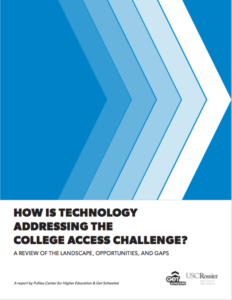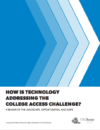
Which digital tools help students pursue higher education?
A joint report by Pullias Center and Get Schooled provides a handy guide.
Download: Full report (PDF) | Press release (Word)
Many digital tools aimed at helping high school students move on to college have been developed in recent years. But which tools are readily available and appropriate, especially for low-income students?
 A new report called “How is Technology Addressing the College Access Challenge?” offers a handy list. Created by USC’s Pullias Center for Higher Education and nonprofit Get Schooled, the report provides descriptions of available tools, “so that practitioners, students, and families can easily identify the most appropriate tools based on students’ particular needs.”
A new report called “How is Technology Addressing the College Access Challenge?” offers a handy list. Created by USC’s Pullias Center for Higher Education and nonprofit Get Schooled, the report provides descriptions of available tools, “so that practitioners, students, and families can easily identify the most appropriate tools based on students’ particular needs.”
The report also provides an assessment of the extent to which the technology field has substantially contributed to closing the college opportunity gap. According to the report’s findings, only a third of college access tools are tailored to high need populations, and the tools that target low-income and minoritized youth have a relatively small user base.
“For nearly a decade, education leaders have suggested that technology can play a meaningful role in closing the college opportunity gap,” said Zoë B. Corwin, Associate Professor of Research at Pullias Center. “Unfortunately, our research has found that serious barriers exist to using technology effectively inside and outside of schools.”
While there are a number of tools that focus on high achieving, low-income students, few have space and information for average low-income students.
“Low-income students need good, straight forward information as well as ongoing encouragement to navigate the complex path between high school and postsecondary education,” said Marie Groark, Executive Director of Get Schooled. “There is continued demand for tools that give students and their families the information they need to access the highest quality, lowest cost education possible that fits their career goals.”
The report recommends that governments and philanthropies continue to be actively involved in supporting the use of relevant digital tools about college – encouraging collaboration between public and private sectors – to ensure all low-income students are aware of and have access to tools specifically designed for their needs.
For the last four years, Pullias Center and Get Schooled have worked in partnership to expand college access through digital tools and games. The two organizations will continue to collaborate, expanding their research and expertise to the college student population by developing tech tools to help improve first-year retention rates at CSU Dominguez Hills.

How is Technology Addressing the College Access Challenge?: A Review of the Landscape, Opportunities, and Gaps
Pullias Center for Higher Education and Get Schooled (2018)
Many digital tools aimed at helping high school students move on to college have been developed in recent years. But which tools are readily available and appropriate, especially for low-income students? This report offers a handy list, with descriptions of available tools.
Created by USC’s Pullias Center for Higher Education and nonprofit Get Schooled, the report also provides an assessment of the extent to which the technology field has substantially contributed to closing the college opportunity gap.
Categories: Digital Equity, College Access, Guides
app college access digital equity financial aid mentoring scholarships technology tools websites
Download 4.00 KB 24107 Downloads